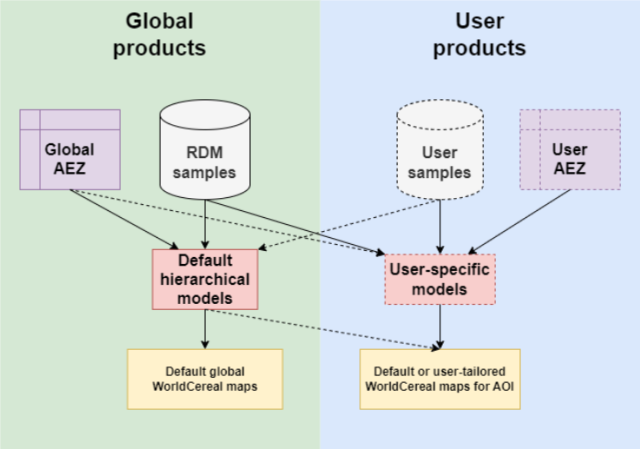Extension of crop types
During WorldCereal Phase I, we released the first global, seasonal crop type maps for maize, winter cereals and spring cereals. During WorldCereal Phase II, we aim to extend the number of supported crop types to include the major cereal crops grown worldwide, including maize, winter cereals, spring cereals, sunflower, rapeseed, millet, sorghum, wheat, barley, rye and soybean. This will require an extensive update of the WorldCereal crop calendars and agro-ecological zones (AEZ) to make sure all targeted crops are covered by our crop calendars. The WorldCereal AEZ will also be redefined based on administrative boundaries, enabling easier local crop monitoring and comparison with official agricultural statistics. Next, the classification workflows themselves will be revised to better allow the system to deal with a multitude of crop types. The current system of independent binary crop type classification models will be replaced by a hierarchical crop type modelling workflow. Finally, addition of new crop types also means a large focus will remain on the collection and harmonization of in-situ reference data in the WorldCereal Reference Data Module (RDM), which will partially be facilitated through more intensive engagement with the end user through regional use cases and dedicated capacity building activities.
By using our new cloud-based processing system, any user will be able to generate crop type maps for a custom area and agricultural season.
Customized crop type models
Aside from the extended native support of crop types by the system, a user will also have the possibility to use the WorldCereal system to train fully customized crop type models for a particular area of interest (see figure). Based on user-provided training samples (in combination with the wealth of data already offered through the RDM), customized AEZ and crop calendars, the user can train dedicated crop type models which he/she can apply to a custom area of interest. Customized crop type models will remain private. To fully enable this functionality, the crop type legend employed in the WorldCereal RDM will be revised and extended to ensure any crop type can be easily added, a dedicated user interface will be built to facilitate upload and harmonization of user-provided reference data and additional data quality checks will be provided to ensure only the best training data is employed by the system.
Downstream applications
Last but not least, the usefulness of the WorldCereal classification products for downstream agricultural applications will be tested and demonstrated by integration of a new crop yield estimation component into the WorldCereal system. This work will be based on the Agriculture Remotely-sensed Yield Algorithm (ARYA), which has been previously successfully applied by NASA Harvest to supply official forecasts for wheat and sunflower production in Ukraine.

